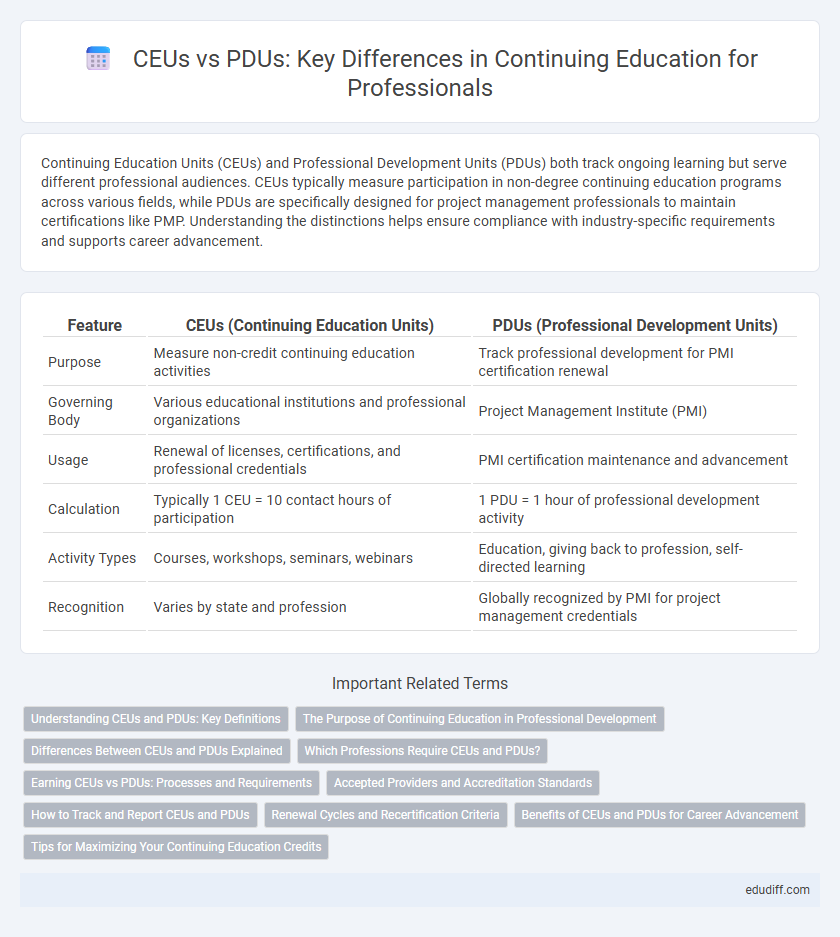Continuing Education Units (CEUs) and Professional Development Units (PDUs) both track ongoing learning but serve different professional audiences. CEUs typically measure participation in non-degree continuing education programs across various fields, while PDUs are specifically designed for project management professionals to maintain certifications like PMP. Understanding the distinctions helps ensure compliance with industry-specific requirements and supports career advancement.
Table of Comparison
| Feature | CEUs (Continuing Education Units) | PDUs (Professional Development Units) |
|---|---|---|
| Purpose | Measure non-credit continuing education activities | Track professional development for PMI certification renewal |
| Governing Body | Various educational institutions and professional organizations | Project Management Institute (PMI) |
| Usage | Renewal of licenses, certifications, and professional credentials | PMI certification maintenance and advancement |
| Calculation | Typically 1 CEU = 10 contact hours of participation | 1 PDU = 1 hour of professional development activity |
| Activity Types | Courses, workshops, seminars, webinars | Education, giving back to profession, self-directed learning |
| Recognition | Varies by state and profession | Globally recognized by PMI for project management credentials |
Understanding CEUs and PDUs: Key Definitions
Continuing Education Units (CEUs) measure participation in non-degree professional development courses, typically requiring 10 contact hours of instruction per unit. Professional Development Units (PDUs) quantify the ongoing learning activities needed to maintain certifications, especially in project management, with one PDU equaling one hour of learning. Recognizing these key definitions helps professionals choose the appropriate credits for career growth and credential renewals.
The Purpose of Continuing Education in Professional Development
Continuing Education Units (CEUs) and Professional Development Units (PDUs) serve to enhance professionals' skills and knowledge within their respective fields, supporting ongoing competence and career growth. CEUs are typically awarded for participation in educational programs to maintain licensure or certification, while PDUs often correspond to activities that fulfill requirements set by professional organizations, such as the Project Management Institute. Both CEUs and PDUs emphasize lifelong learning, ensuring professionals stay current with industry standards and best practices.
Differences Between CEUs and PDUs Explained
CEUs (Continuing Education Units) measure participation in accredited educational programs to maintain professional licenses and certifications, typically quantified as 0.1 CEU per hour of instruction. PDUs (Professional Development Units) are specific to PMI's PMP certification, representing professional development activities that contribute to skill enhancement and certification renewal over a three-year cycle. Unlike CEUs, which cover a broad range of professions, PDUs emphasize project management competencies and require detailed tracking within PMI's CCR program.
Which Professions Require CEUs and PDUs?
Licensed professionals such as nurses, teachers, engineers, and social workers require Continuing Education Units (CEUs) to maintain their certifications and licenses. Project Management Professionals (PMPs) and other certified project managers typically need Professional Development Units (PDUs) to renew their credentials through the Project Management Institute (PMI). Both CEUs and PDUs ensure ongoing professional competence and adherence to industry standards.
Earning CEUs vs PDUs: Processes and Requirements
Earning Continuing Education Units (CEUs) typically involves participation in accredited courses, workshops, or seminars with a set number of contact hours recognized by professional bodies. Professional Development Units (PDUs) require engagement in activities aligned with PMI's Talent Triangle, including technical project management, leadership, and strategic and business management, often verified through documented learning and experience. Both CEUs and PDUs mandate maintaining detailed records and submitting evidence for certification renewal, but PDUs emphasize diverse skill development aligned with project management standards.
Accepted Providers and Accreditation Standards
CEUs are primarily issued by accredited continuing education providers recognized by organizations such as the International Association for Continuing Education and Training (IACET), which ensures compliance with ANSI/IACET standards. PDUs are awarded by registered providers approved by PMI, adhering to the PMI Talent Triangle framework and their strict accreditation criteria. Both CEU and PDU providers must maintain rigorous standards of content quality, learning objectives, and participant assessment to secure and retain accreditation.
How to Track and Report CEUs and PDUs
Tracking CEUs involves maintaining detailed records of completed courses, including certificates or transcripts that specify credit hours and course content. PDUs require professionals to document activities aligned with PMI's Talent Triangle, submitting these through the PMI CCRS portal with supporting evidence such as certificates or event confirmations. Accurate reporting ensures compliance with certification renewal requirements and facilitates seamless recertification processes.
Renewal Cycles and Recertification Criteria
CEUs (Continuing Education Units) typically require renewal every two to three years, depending on the professional organization's standards, while PDUs (Professional Development Units) often follow a three-year cycle aligned with PMI's Project Management Professional (PMP) certification. Renewal cycles for CEUs involve completing specified educational hours and submitting proof of participation, whereas PDUs mandate a combination of education, giving back to the profession, and organizational contributions to meet recertification criteria. Both CEUs and PDUs ensure professionals maintain current skills, but PDUs emphasize a diverse approach to professional growth beyond traditional coursework.
Benefits of CEUs and PDUs for Career Advancement
CEUs and PDUs provide industry-recognized credentials that enhance professional credibility and demonstrate commitment to continuous learning. Accumulating CEUs and PDUs helps meet certification renewal requirements, ensuring professionals stay current with evolving standards and best practices. Both contribute to career advancement by expanding expertise, increasing marketability, and opening opportunities for higher-level positions.
Tips for Maximizing Your Continuing Education Credits
Maximize your CEUs and PDUs by aligning courses with your specific certification requirements and industry standards to ensure credit relevance. Track all course completions using digital tools or apps that provide reminders for renewal deadlines and credit hour accumulation. Prioritize accredited providers and diverse learning formats, such as webinars, workshops, and online modules, to broaden knowledge while optimizing flexibility and time management.
CEUs vs PDUs Infographic

 edudiff.com
edudiff.com